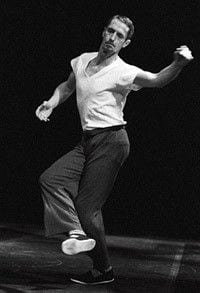To say I’m excited for Contact Improvisation is an understatement…
I can not wait to discover what contact improvisation is truly about, how I can train my body to sense my peers intentions and feelings when moving together. To deepen my movement knowledge and self awareness of my body as a being rather than a tool.
Knowing that this week was only a taster of what is to come for the rest of the year, makes me want to push myself into every exercise and challenge that is thrown at me. This weeks class has already taught me a lot about Contact Improvisation, it has taught me that you have to think about the other person more than yourself, you have to trust who you are working with to get the best out of the class and finally that Contact Improvisation relies fundamentally on touch.
The reading ‘Moving from the Skin’ was the one I found the most interesting, I feel that it related to the class the most. This is because it relates to my point I mentioned earlier that Contact Improvisation relies mainly on touch. ‘One of the most important elements of Contact Improvisation is communication by touch, both by touching and by being touched.’ (Heitkamp, D 2003) Describing touch as a way of communicating sparks an intriguing thought of how many other ways can we communicate with each other without moving our mouths. The reading also talks about the 3 different functions of the skin. I’ve only ever thought of the skin as a layer that protects the organs and vessels within my body, but studying the reading in depth made me realise that skin is the way we communicate with others whether this is in Contact Improvisation or in everyday life. ‘In its third function, the skin-no less than the mouth- is the site and primary means of communication and development of meaningful relationships.’ (Heitkamp, D 2003)
The second reading ‘Drafting Interior Techniques’ by Steve Paxton was a fundamental reading for getting to know the history of how Contact Improvisation was formed, since Steve Paxton was the founder. Paxton describes Contact Improvisation as ‘a physical event best described negatively: not art, not sport, not most of the things that characterize dancing in this century.’ If this is the case it leaves me with the question of what exactly does the founder of Contact Improvisation best describe his way of dancing as?
As a beginner in Contact Improvisation I would describe it as a way of communicating with a person by senses such as touch, through unconventional ‘dance’ movements. I am interested to see that as I learn more about this way of moving whether my ‘definition will change or my views on Contact Improvisation. Hopefully I will not loose my excitement and interest in the subject and my want to know more and develop my skills will only become stronger.
Bibliography
Paxton, S. Drafting Interior Techniques. In Stark-Smith, N. A Subjective History of Contact Improvisation. In Albright, A. C., & Gere, D. (2003). Taken by surprise: A dance improvisation reader. Middletown, Conn: Wesleyan. University Press. Pp.175-184
Heitkamp, D. (2003). Moving from the Skin: An Exploratorium. Contact Quarterly/ Contact Improvisation Sourcebook II, Vol. 28:2. Pp. 256-264